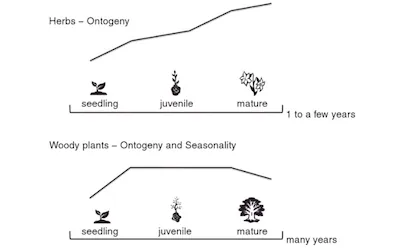Plant Secondary Metabolites
Updated | 2020-05-26
Reviewed by the NatureClaim Team

First off, a metabolite, as defined in a dictionary, is "a substance necessary for or taking part in a particular metabolic process. Examples of metabolites are glucose in the metabolism of sugars and starches, amino acids in the biosynthesis of proteins, and squalene in the biosynthesis of cholesterol."
In the book, The Ecology of Plant Secondary Metabolites: From Genes to Global Processes, contributing authors Julia Koricheva and Kasey Barton discuss plant secondary metabolite production. What excited me was their Figure 3.5 (the image above was modified from their article).
The figure shows an increase in secondary metabolites in herbs throughout their growth. In fact, the figure shows that secondary metabolites are constantly increasing in herbs. In other plants, this is not the case. Woody plants, for example, start life as a seedling and the secondary metabolites grow as it grows. When it reaches the juvenile stage, though, these metabolites stop and the secondary metabolites flat line—neither increasing nor decreasing. At maturity, this changes again. The secondary metabolites begin to decrease.
Many herbs have positive medicinal effects for humanity and these compounds are one of the reasons they are beneficial. In herbs, the production of these metabolites continues throughout the life of the herb. Can this be one of the reasons mature herbs have medicinal traits that can impact positively on our health?
In addition, Savithramma et al. (2011) showed in the following study that
Secondary metabolites are responsible for medicinal activity of plants. Hence in the present study phytochemical screening of some important medicinal plants was carried out. Qualitative phytochemical analysis of these plants confirms the presence of various phytochemicals like saponins, terpenoids, steroids, anthocyanins, coumarins, fatty acids, tannins, leucoanthocyanins and emodins. The results suggest that the phytochemical properties for curing various ailments and possess potential antioxidant and leads to the isolation of new and novel compounds.
So the answer to the question that mature herbs have a more positive impact on human health appears to be yes, but, of course, we have to do more research before the answer is a resounding YES.
Reference(s):
Savithramma N, Rao ML, Suhrulatha D. Screening of medicinal plants for secondary metabolites. Middle-East Journal of Scientific Research. 2011.
"Plant Secondary Metabolites" was written by Michael Brownstein
